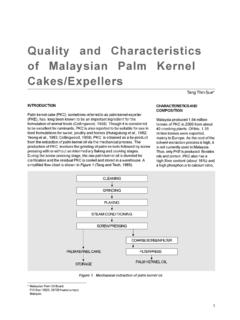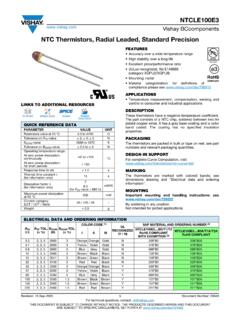Transcription of FATTY ACID COMPOSITION OF EDIBLE OILS IN THE …
1 1 FATTY ACID COMPOSITION OF EDIBLE OILS IN THE malaysian market , with special reference TO TRANS- FATTY ACIDS* malaysian Palm Oil Board, Box 10620,50720 Kuala Lumpur, TTY TTY TTY TTY AAAAACID COMPOSITION OFCID COMPOSITION OFCID COMPOSITION OFCID COMPOSITION OFCID COMPOSITION OFEDIBLE OILS IN EDIBLE OILS IN EDIBLE OILS IN EDIBLE OILS IN EDIBLE OILS IN THE MALATHE MALATHE MALATHE MALATHE MALAYYYYYSIAN MARKETSIAN MARKETSIAN MARKETSIAN MARKETSIAN market ,,,,, with special reference with special reference with special reference with special reference with special reference TTTTTOOOOOTRANSTRANSTRANSTRANSTRANS-F-F- F-F-FAAAAATTY TTY TTY TTY TTY AAAAACIDSCIDSCIDSCIDSCIDSTANG, T S*ABSTRACTABSTRACTABSTRACTABSTRACTABSTRA CTA total of 113 samples of various types of palm and palm kernel oil products, their fractions, palm-based andnon-palm-based cooking oils obtained from local manufacturers and the retail market were analysed for theirtrans- FATTY acid compositions and contents by capillary gas chromatography.
2 Trans- FATTY acids were generallyabsent in crude palm and palm kernel oils. However, they were present at in refined palmkernel products and 0% in refined palm products, all well below the level stipulated by someimporters. These trans- FATTY acids were formed from their natural cis-isomers as a result of the high temperatureused during cooking oil, the trans- FATTY acid contents of palm-based products were , again wellbelow 1%. However, in the non-palm-based cooking oils, the contents of the 14 samples ranged The higher contents in the non-palm-based oils were expected as they had high contents ofunsaturated FATTY acids, which are more prone to isomerization at elevated of Oil Palm Research Vol.
3 14 No. 1, June 2002, p. 1-8 Keywords: trans- FATTY acids, FATTY acid COMPOSITION , EDIBLE oils, palm-based cooking oils, non-palm-based cooking nutritional attributes of trans- FATTY acids havebeen a subject of concern among food scientists,nutritionists and consumers. A report by Mensinkand Katan showed that trans- FATTY acids affectcholesterol levels in much the same ways assaturated FATTY acids (INFORM, 1990). Other animalstudies have also revealed many adverse nutritionaleffects of trans-acids. They have been implicated asdetrimental to health in terms of the metabolism ofessential FATTY acids, coronary heart and cardio-vascular diseases (Sundram and Chang, 2000), foetaland infant development, and in the treatment ofhypercholesterolemia (Simopoulos, 1996; Ong andChee, 1994; Sundram, 1993).
4 In natural vegetable oils, the unsaturated acidsare present in the cis-form. However, highlyunsaturated vegetable oils are not suitable for manyfood applications such as margarines, shortenings,confectionery fats and vanaspati, where solid fats arerequired. They are thus hardened by catalytichydrogenation during which the naturally occurringcis-unsaturated FATTY acids are partly converted tothe unnatural trans-isomer (Figure 1). Small amountsof trans- FATTY acids are also formed from heat-induced isomerization during deodorization underhigh temperature (Kovari et al., 1997; Bertoli et al.,1997). The extent of isomerization is more serious inpolyunsaturated oils.
5 Depending on the type ofunsaturated acids, different trans-isomers can beformed from the original cis-unsaturated FATTY 2 illustrates the possible trans-isomers that canbe derived from linoleic and linolenic a result of the many suspected undesirableeffects of trans-acids, scientists have been2 JOURNAL OF OIL PALM RESEARCH 14 (1)per reference amount customarily consumed and perlabelled serving of the food. Generally, a serving isabout 14 g for EDIBLE oil. The FDA is currently seekingcomments on its proposals (FDA, 1999).Since the early controversy in the eighties, manysurveys on the content of trans- FATTY acids in fattyfoods, such as margarines, bakery fats and friedproducts, in several countries have been them are those for America (Enig et al.)
6 ,1983; Slover et al., 1985; Postmus et al., 1989), Canada(Ratnayake, 1991; Postmus et al., 1989), France(Bayard and Wolff, 1995), Austria (Henninger andUlberth, 1996), Belgium (De Greyt et al., 1996),Denmark (Oveson et al., 1996), Germany (Fritscheand Steinhart, 1997a, b) and the United Kingdom(Kohiyama et al., 1991; Anon., 1997b). Several othersimilar surveys for Greece, Italy, New Zealand,campaigning for the avoidance of hydrogenation inthe processing of oils and fats for EDIBLE use (Anon.,1991; 1997a; Schwarz, 2000) and also for mandatorylabelling of the content of trans- FATTY acids as aseparate category in food items (Simopolous, 1996).
7 The United States Food and Drug Administration(FDA) proposed in November 1999 its rules for trans- FATTY acids in nutrition labelling, nutrient contentclaims and health claims (Thiagarajan, 2000). Theproposals recommended that the trans-fat free claimbe permitted for foods that contain less than gtrans- FATTY acids and less than g saturated fatsOleic acid (cis-9-Octadecadienoic acid)CH3 (CH2)7(CH2)7 COOH C = C H HElaidic acid (trans-9-Octadecadienoic acid)CH3 (CH2)7H C = C H(CH2)7 COOHF igure 1. Cis-trans -isomers of 9-Octadecadienoic acid. Isomerization pathway of linoleic acid (cis, cis-9,12-Octadecadienoic acid)cis, ciscis, trans trans, cis trans, transIsomerization pathway of linolenic acid (cis-, cis-, cis-9,12,15-Octadecatrienoic acid) cis, cis, ciscis, cis trans trans, cis, ciscis, trans, cistrans, cis, trans cis, trans, trans trans, trans, cis trans, trans, transFigure 2.
8 Isomerization of polyunsaturated FATTY , Australia and Finland were mentioned in thereport by Henninger and Ulberth (l996). A summaryof the data from these reports is given in Table late, some European importers arepreferentially sourcing palm oil products with amaximum trans- FATTY acid content of (Pantzaris,1997). A short survey of palm oil products andcooking oils from refineries and available in the localmarket was therefore carried out to ascertain thelevels of trans- FATTY determination of trans- FATTY acids content inoils and fats is normally carried out by either infrared3 FATTY ACID COMPOSITION OF EDIBLE OILS IN THE malaysian market , with special reference TO TRANS- FATTY ACIDS spectroscopy (IR)
9 Or capillary gas this survey, all the samples were analysed by gaschromatography as the IR method lacks sensitivityand is not reliable if the total trans- FATTY acids contentis below 5% (Duchateau et al., 1996; Ulberth andHenninger, 1996). Capillary gas chromatography candetect down to It can also separate thedifferent trans-isomers in polyunsaturated oils,provided a column of suitable length and coatedwith a higher polar stationary phase is TERIALS TERIALS TERIALS TERIALS AND METHODSAND METHODSAND METHODSAND METHODSAND METHODSS amplesSamplesSamplesSamplesSamplesA total of 113 different types of palm oil, palmkernel oil, their fractionated products (which wereall unhydrogenated) and cooking oils were obtainedfrom palm oil refineries throughout Malaysia andlocal FATTY acid standards used were from SigmaChemicals.
10 They included lauric, myristic, palmitic,stearic, oleic and elaidic acids. The standard FATTY acidmixture for calibration was obtained from Supelco,USA (RM-6 for palm products, RM-5 for palm kerneloil products and RM-1 for non-palm-based cookingoils). All the reagents and solvents used were of oftion oftion oftion oftion of F F F F Faaaaatty tty tty tty tty Acid MethAcid MethAcid MethAcid MethAcid Methyl Esteryl Esteryl Esteryl Esteryl Esters (Fs (Fs (Fs (Fs (FAME)AME)AME)AME)AME)FAMEs of the samples were prepared accordingto PORIM Test Method About g of the oilwas dissolved in ml hexane and ml sodiummethoxide.











